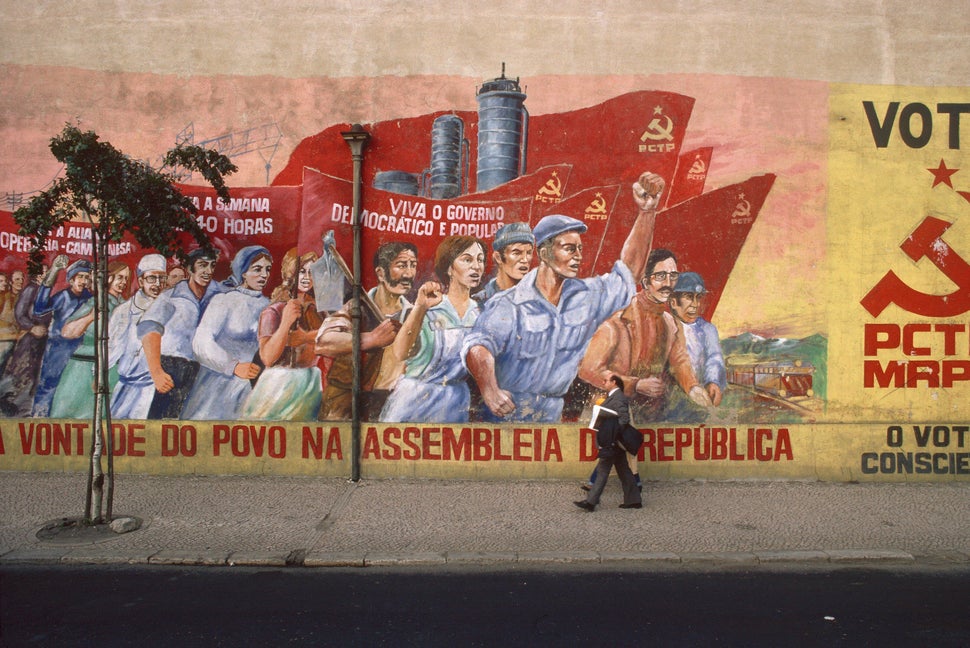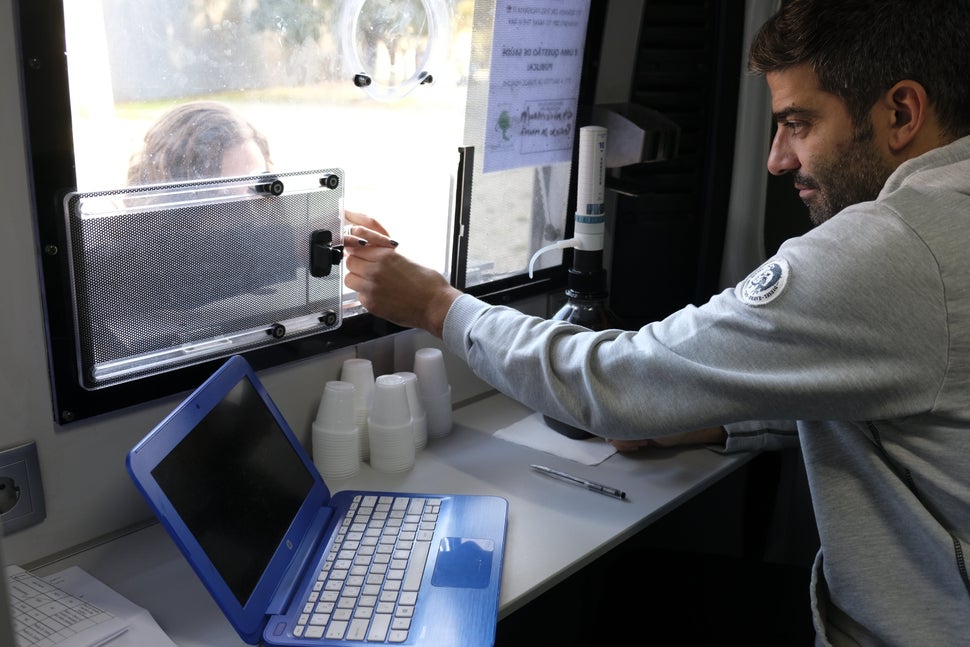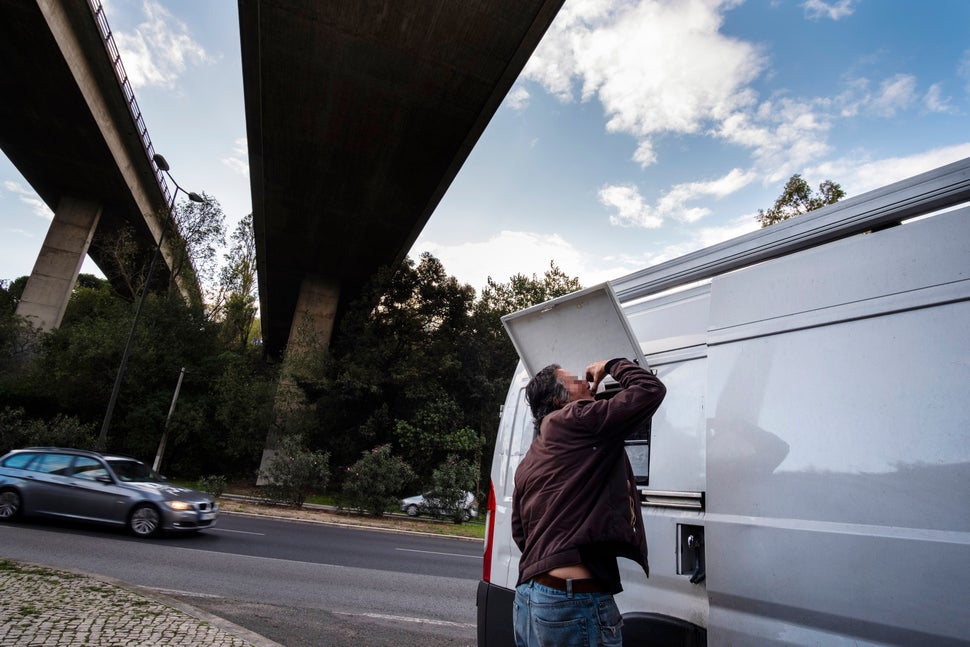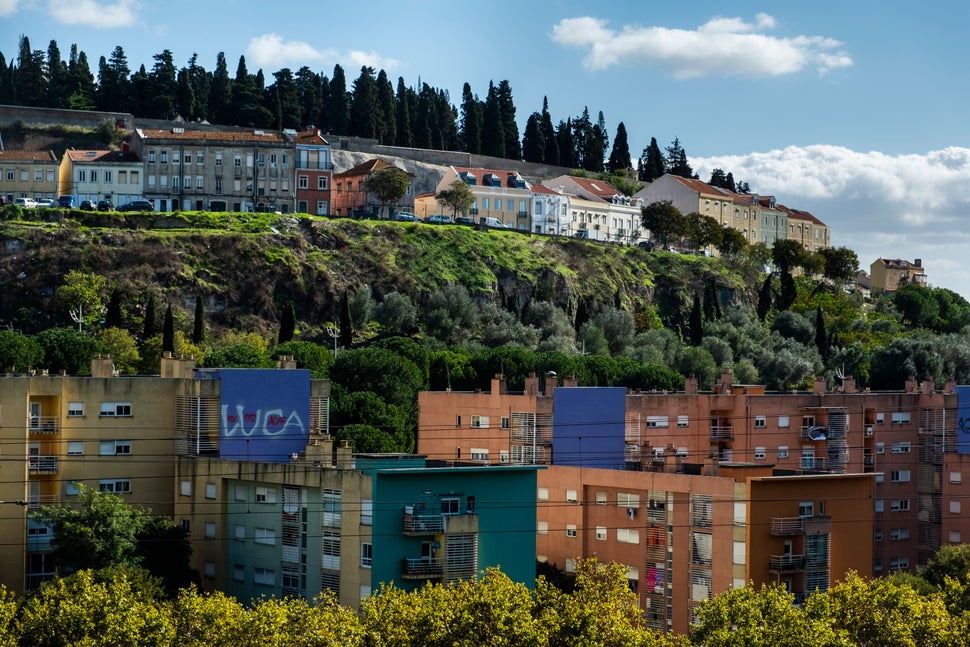
Portugal Solved Its Drug Crisis. Why Can’t America Do The Same?
11/09/2019LISBON, Portugal ― In an obscure corner of the huge, ugly building that houses Santa Maria Hospital, lies the psychiatry department. A cluster of men mill around outside the office of psychiatrist Nuno Félix da Costa, waiting for their group therapy to start. Almost all are at least 40, some much older. Hardship is etched onto their faces. Deep wrinkles speak to long periods on the streets; gaunt cheeks and sagging skin are evidence of a lengthy history of drug abuse.
One of them goes to get a snack from a vending machine and punches the glass when the coin is returned. Another keeps saying he’s in a hurry to get his prescription before he goes to work at 6 p.m. (it’s not even 3 p.m.). For years, these men did whatever was necessary to get their drugs of choice, usually heroin. They lost their jobs and often their families. Some have spent time in prison.
They are casualties of the drug crisis that gripped Portugal from the late ’70s onward, leaving an estimated 1 in 100 people addicted to heroin by the late 1990s. But these men are also survivors. With access to health care and enrollment in a treatment program, they are symbolic of a radical turnaround in how the country decided to treat drug addiction.
Instead of doubling down on the policy of repression and criminalization it had been pursuing ― similar to America’s war on drugs stance ― Portugal became the first country to decriminalize all drugs. Drugs were still illegal and people would still be prosecuted for supplying or trafficking drugs, but those caught with small quantities would not be arrested.
Decriminalization was the most prominent part of a package of reforms designed to take a humane approach to addiction, to treat it as a disease rather than a moral failing. Drug users would be viewed as patients, not as criminals, and they would be met with treatment, rather than incarceration.
The approach worked. Over the last nearly two decades, the number of heroin users in Portugal has been cut by two thirds and drug-related deaths have plummeted from more than one a day in 1999 to 30 in all of 2016. The fall in new drug-related HIV infections has been even more striking, with 18 recorded in 2016, according to a 2019 report by the European Monitoring Centre for Drugs and Drug Addiction, compared with 907 in 2000.
The roots of Portugal’s drug crisis can be traced back to the 1970s. A bloodless coup in 1974 known as the Carnation Revolution brought democracy to Portugal, releasing it from nearly five decades of isolation imposed by the dictatorship of António Salazar. The country quickly opened up to the world at a time when drugs from countries like Afghanistan were flooding into Europe. These quickly made their way into Portugal, its long coastline providing many points of access.
By the 1980s, the country was plunged, totally unprepared socially or culturally, into a drug epidemic that was made much worse by the start of the AIDS crisis. But politicians didn’t act. Primarily concerned with stabilizing the young democracy, they neglected the problem, which quickly degenerated into a huge crisis.
The tragedy unfurled across all social classes. The shame it carried for many families made it difficult to talk publicly about the issue. There were hundreds of overdoses every year: 369 people died by overdose in 1999.
“Every family had someone on drugs or who had died of it, or knew someone close who had,” explains Félix da Costa, who’s been at the forefront of treating drug addiction for the past three decades.
Jails were filled with drug addicts. Drug use, at the time, was still subject to jail terms that could reach two years and were often applied in an arbitrary manner, depending on the vagaries of an overloaded and unprepared judicial system.
One of the most striking manifestations was the phenomenon of the “arrumadores” ― young heroin addicts who would help you park (arrumar) your car in exchange for money, with an implicit threat that if you didn’t pay, something might happen to it while you were away.
Although the official response was repression, this did nothing to stem the problem. As it worsened, slowly attitudes started to evolve. The drug crisis, increasingly visible in some poor neighborhoods, spread to city centers.
In the mid-’80s, João Goulão, then a young doctor in The Algarve, in southern Portugal, found an increasing number of his patients were coming to him with problems related to drug addiction. “I wasn’t a specialist in drugs,” he says, “but I was available whenever people came to me.” Like other community doctors around the country at the time, he accidentally became an expert in treating drug addiction.
Goulão would end up becoming one of the main figures in the decriminalization effort.
The experience he gathered at the frontline of Portugal’s drug crisis led to him taking a lead role in efforts to set up public centers for treating drug addiction (known by their acronym: CAT) around the country in the late ’80s.
The first center was established in Lisbon in 1987 and run by the Ministry of Health. Using this as a model, Goulão and his colleagues started to open other centers around the country, beginning in Faro in 1988. Each center provided local, community support to those addicted to drugs.
It was part of a gradual shift to a more health-centered approach to dealing with drug addiction, which built up over the late ’80s and the ’90s.
While a syringe substitution program had long been in operation, in 1993 this was expanded from hospitals into street pharmacies, greatly increasing the program’s effectiveness, says Goulão. Anyone could arrive at a participating pharmacy with a used syringe and exchange it for a clean one, no questions asked. Methadone, which had been prescribed in northern Portugal to treat heroin addiction since 1977, spread to the rest of the country starting in 1990.
But it wasn’t until the late 1990s that the country began considering legislative reform. The government asked experts, including doctors, social work professionals and a judge, to come up with a plan for how Portugal should tackle its drug crisis. Goulão, then president of the Serviço de Prevenção e Tratamento da Toxicodependência (Service for the Prevention and Treatment of Drug Addiction), was part of that group.
The plan, presented in 1998, recommended a focus on a humane approach including action to prevent addiction in the first place and treating rather than punishing those addicted, as well as policies to help people reintegrate into society. It laid the foundations for the 2001 law to decriminalize drugs.
Set out for the first time as a package of reforms, the plan appeared radical. It was a bold departure from conventional wisdom on how to tackle the drug epidemic, especially for a socially conservative country. But, says Goulão, in reality, it was just building on a number of practices that were already underway. “In a way, it formalized them,” he says.
There were obstacles. Politicians on the right warned that the country would become a magnet for drug addicts. But the country’s parliament approved the plan, bolstered by the widespread feeling that repression was not working and something had to be done to tackle the crisis.
As positive results began to appear ― fewer drug-related deaths, fewer new HIV infections and fewer people addicted to drugs ― decriminalization began to find support across the political spectrum. That Goulão who currently heads up the national agency to reduce drug addiction, has survived eight governments of different political strokes without losing his role as drug czar, is a testament to that.
On the first floor of a nondescript office building near the center of Lisbon, Francisco, a nervous-looking man in his early 20s, paces the floor. He is waiting to go before Lisbon’s Drug Addiction Dissuasion Commission (CDT) to learn his fate.
There is a CDT in each of Portugal’s 18 districts, and they represent one of the most visible elements of Portugal’s drug approach. People found with drugs on them in quantities small enough to indicate they are for their own consumption ― defined as an amount for around 10 days of personal use ― are sent before a CDT panel, usually made up of a lawyer and a medical professional or social worker. In Francisco’s case, it is the head of the CDT and a lawyer.
Francisco tells the panel he has taken drugs no more than a few times in his life, only over the past six months. The CDT members don’t question Francisco’s account; instead, they talk about the health implications of drugs and note drug use is still illegal. He is then free to go, with the message that if he ever needs help, he can contact them.
Francisco’s experience is fairly routine. If someone is caught a second time, there could be an administrative sanction ― a small fine, for example. But sanctions are rare. It’s far easier to get a fine for a traffic violation in Portugal than it is to get a fine for possessing drugs. People who are found to have an addiction problem are never fined, says Goulão.
The real aim is to open a door to the health system, especially for people who are addicted, that they can use if they want to. Treatment is always voluntary but it is encouraged.
Portugal hasn’t eradicated drugs, by any stretch, and there are concerns that the progress made so far cannot be maintained. Tackling drug addiction has fallen down the government’s priority list, says Goulão. He fears a lack of funding, and the grim, hard realities of treating drug addiction, could jeopardize the program and its success. “This is no longer a hot, sexy area,” he says.
But still, Portugal’s success in tackling the crisis sets it apart from its neighbors ― levels of drug use in the country are among the lowest in Europe. The country’s drug-induced death rate in 2017 was 5.5 times lower than the European average, and more than 50 times lower than the U.S. in the same year.
While critics worried that decriminalization would turn the country into a destination for drug users, this hasn’t happened. The policy of viewing addiction as a health issue rather than through a criminal justice lens has remained in place for nearly two decades. It also survived the financial crisis, which led to a temporary uptick in drug use, partly because certain elements of the support system suddenly disappeared, explains Goulão.
According to Goulão, 20 years ago there were about 100,000 heroin addicts in Portugal. The latest data shows there are now just over 33,000 people using high-risk opioids. About 25,000 of these are heroin users, according to the Ministry of Health.
There could be lessons here for the U.S., currently in the middle of an overwhelming opioid crisis, which claimed an estimated 68,500 lives in 2018. Drug-related deaths are on the rise in the country that has stuck firmly to policies of criminalization.
There are some signs of positive change in America, however, says Ethan Nadelmann, who founded the Drug Policy Alliance, a group based in New York City campaigning against the war on drugs.
Some U.S. states have taken tentative steps down the path of legalization. Cannabis, for example, is now legal for recreational use in 11 states and the District of Columbia. And Nadelmann says he sees growing support among people and some policymakers for an approach that views drugs as a medical problem.
But the U.S. is different from Europe, he says, in ways that make bigger changes feel unlikely anytime soon. Society is different. “The [U.S. social] support system is not as robust,” says Nadelmann.
Plus there is less tolerance for addiction. “There is a much stronger tradition of sobriety being a moral issue,” says Nadelmann. In the U.S., generally speaking, when you’re caught with drugs the lucky ones may get a chance to go into treatment. But if the treatment proves ineffective, you may go to prison. “We have less patience,” he says.
What may prove a catalyst to change is the breadth of the current opioid crisis. “Just as in Portugal, the fact that the [drug] problem happened across all social classes gave us a window of opportunity to implement these progressive policies,” says Goulão. “The moment of the opioid crisis in the U.S. can be used by activists, consumer associations, other progressive people, to switch the focus from the war on drugs to a more realistic policy.”
In Portugal, the essence of the system is recognizing that treatment tends to fail the first time, and often many times after that, and the door should be kept open. The person should be kept inside the health system, not outside it.
Before Portugal changed its approach, says Félix da Costa, there were huge numbers of long-term drug users who had never had any treatment. “I’ve had cases of people who had been doing drugs for 30 years and coming [to my practice] was the first time they actually went into treatment,” he says. An emphasis on a humane approach over punishment and a government willing to put money and resources behind it, mean fewer people fall between the cracks. Those whose lives have been ravaged by drug addiction, he says, like the men outside his office, are much rarer these days.
If it matters to you, it matters to us. Support HuffPost’s journalism here. For more content and to be part of the “This New World” community, follow our Facebook page.
HuffPost’s “This New World” series is funded by Partners for a New Economy and the Kendeda Fund. All content is editorially independent, with no influence or input from the foundations. If you have an idea or tip for the editorial series, send an email to [email protected].
BEFORE YOU GO
Source: Read Full Article






